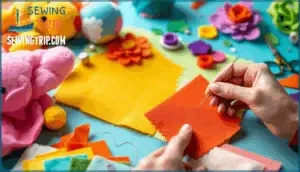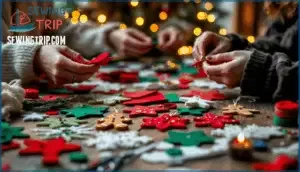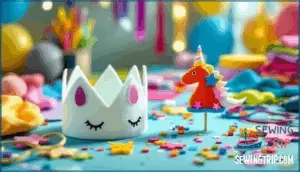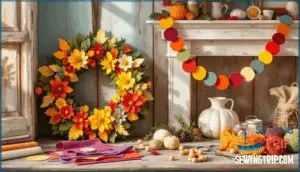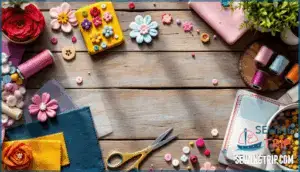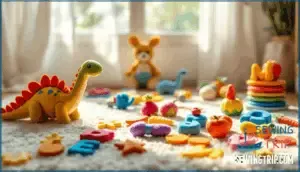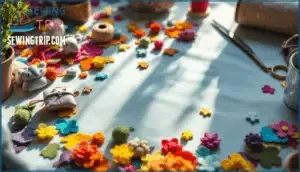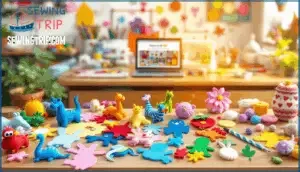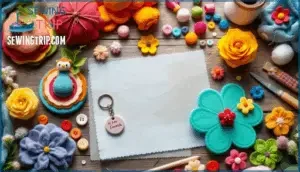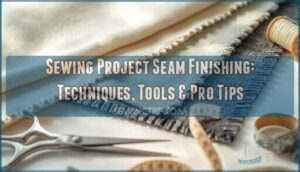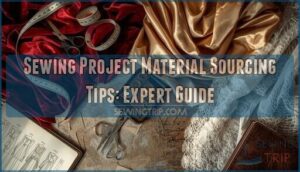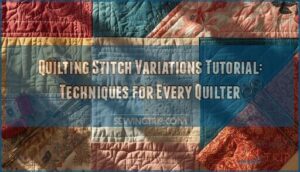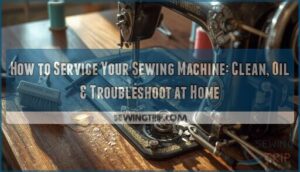This site is supported by our readers. We may earn a commission, at no cost to you, if you purchase through links.

That’s why fun sewing projects using felt are perfect whether you’re teaching a kid their first stitch or speed-crafting decorations the night before a party. From tiny stuffed animals that fit in your palm to bold wreaths that command attention on your front door, felt bends to your skill level without complaint.
The best part? Mistakes rarely look like mistakes—they just add character. If you’ve got scraps lying around or a fresh stack of colorful sheets, you’re already equipped to make something useful, giftable, or just plain cute.
Table Of Contents
- Key Takeaways
- Essential Supplies for Felt Sewing Projects
- Tips for Working With Felt Fabric
- Beginner-Friendly Felt Sewing Techniques
- Fun Felt Decorations for Every Occasion
- Easy Felt Accessories to Sew or Glue
- Felt Toys and Educational Crafts for Kids
- Creative Felt Home Decor Ideas
- Upcycling Felt Scraps Into Small Projects
- Free Patterns and Tutorials for Felt Crafts
- Gift Ideas Using Handmade Felt Projects
- Frequently Asked Questions (FAQs)
- Conclusion
Key Takeaways
- Felt is the ultimate beginner-friendly fabric because it doesn’t fray, unravel, or need hemming—you can cut it with regular scissors and glue it instead of sewing, making mistakes nearly invisible.
- Wool blend felt offers superior durability and colorfastness but costs more ($20-$30/yard), while acrylic felt is budget-friendly (under $10 for multi-packs) and takes dye beautifully for vibrant colors.
- Felt projects span from quick decorations (ornaments, bunting, wreaths) to functional items (coasters, organizers, accessories) to educational toys (play food, finger puppets, quiet books) that all work up fast with minimal supplies.
- Felt scraps are goldmines for upcycling into mini animals, bookmarks, keychains, and appliqué embellishments—nothing needs to go to waste when even tiny pieces can become something giftable.
Essential Supplies for Felt Sewing Projects
Before you start cutting and stitching felt, you’ll want to gather a few key supplies. The good news is that felt projects don’t require fancy equipment or a huge budget.
Let’s walk through what you’ll need to get started with your first felt project.
Choosing The Right Type of Felt
When picking felt for your project, think wool vs. synthetic first. Wool blend felts offer excellent durability and colorfastness—less than 5% fade after heavy sun exposure—but cost $20–$30 per yard. Acrylic/polyester felts shine in budget considerations at under $10 for multi-packs, plus they grab dye beautifully for vibrant craft supplies. Natural wool felt is also biodegradable. Blended felt options balance performance and price.
Felt weight matters too: thicker grades (5–7 mm) work best for structured projects, while lightweight felt scraps suit delicate details. Choosing felt materials wisely sets your whole project up for success.
Recommended Needles and Threads
Once you’ve got your felt locked in, grab the right sewing supplies and tools. For hand sewing, embroidery needles (sizes 6 to 8) are your go-to craft supplies—they’ve got bigger eyes for thicker hand thread like embroidery floss.
Machine sewing? Stick with size 70/10 or 80/12 needles for standard felt layers. Thread material matters: polyester machine thread beats cotton for durability, while embroidery thread (12wt to 20wt) rocks decorative stitches.
Needle size and thread weight work together—larger needles accommodate heavier threads, finer ones keep seams invisible. Using the correct felt needles is essential for successful felt projects.
Adhesives and No-Sew Alternatives
Not ready to sew yet, or want a faster finish? Fabric glue (like Aleene’s or Beacon) bonds felt scraps instantly for easy crafts and no-sew projects. Iron-on adhesives offer fabric fusion without stitching, perfect for felt crafts and quick decorating.
Test adhesive removal on scraps first—some glues stay permanent. Crafting with adhesives cuts time in half!
Useful Cutting Tools and Templates
Sharp scissors make all the difference, so grab a pair of fabric shears (not your regular craft scissors!) to slice through felt like butter. Rotary cutters with self-healing mats give you precision scissors can’t match, especially for straight lines. Pinking shears add decorative zigzag edges that resist fraying.
Acrylic templates help trace shapes perfectly, while die cutting speeds up repetitive patterns. Keep scissors keepers handy so your sewing accessories don’t wander off!
Tips for Working With Felt Fabric
Felt is forgiving, but a few smart tricks make every project look polished. Knowing how to cut, manipulate, and care for felt saves time and frustration.
Here’s what you need to work with felt like a pro.
Cutting Techniques for Clean Edges
If you’ve ever ended up with fuzzy edges that look more like someone attacked your felt with safety scissors, you’re not alone—but the right cutting technique makes all the difference. Sharp scissors or a rotary cutter are your best friends here.
Use templates for precision, and try pinking shears for decorative edges that won’t fray. Die-cutting machines give you perfect shapes every time, while proper edge finishing and sewing techniques keep your projects looking polished and professional.
Preventing Felt From Stretching or Warping
When you’re working with felt—especially thin acrylic-polyester felts—stretching can sneak up on you fast. Wool blend felts keep their shape better, but sewing beginners should use stabilizers (they cut distortion by up to 50%) and choose thicker material for easier manipulation.
Store your felt rolled in low humidity, use sharp needles sized 75/11 or larger, and hoop gently when sewing by hand or machine—proper sewing techniques keep your projects flat and professional-looking.
Ironing and Washing Felt Safely
You might think felt can withstand whatever you throw at it, but heat and water are actually its kryptonite—treat them wrong, and you’ll end up with a shrunken, scorched mess instead of a craft project.
For ironing, use low temperatures (wool setting, max) with a pressing cloth to avoid felt shrinkage and scorch marks. Skip washing methods that involve soaking—spot-clean stains with cold water and mild soap instead.
For drying techniques after stain removal, lay your felt flat on a towel; never wring or tumble-dry. These easy sewing fabric crafts deserve gentle care, especially for beginner sewing projects.
Does Felt Need Hemming or Finishing?
One of the best parts about felt is that it practically finishes itself—no fraying edges means you can skip the hemming hassle and jump straight to the fun stuff. Just snip your shapes and go—no felt edge fraying to worry about.
That said, felt type matters for felt project longevity. Wool felt holds up longer than acrylic, so choose wisely for felt durability tips and lasting easy sewing projects.
Beginner-Friendly Felt Sewing Techniques
You don’t need fancy skills to work with felt—just a few basic techniques that anyone can learn. Whether you prefer hand stitching, machine sewing, or skipping the needle altogether, felt is forgiving enough to make every method work.
Let’s look at the simple approaches that’ll get your projects off to a great start.
Simple Hand Stitches for Felt
Hand stitches reveal the joy of felt sewing without a machine. These basic techniques give beginners confidence while creating durable projects:
- Running stitch – Fast and simple for joining felt pieces with 2–4 mm spacing, completing a 12-inch seam in under three minutes
- Whip stitch – Perfect for stuffed toys, blending raised seams when thread matches felt color
- Blanket stitch – The most durable edge finish, decorative and reinforcing for ornaments and coasters
- Back stitch – Stronger than running stitch, ideal for embroidered facial features and continuous lines
- Ladder stitch – Creates invisible closures for stuffing openings in plush projects
Using a Sewing Machine With Felt
Sewing machines transform felt projects into speed runs, turning what might take twenty minutes by hand into a two-minute task with straight, sturdy seams. Use a universal or sharp needle (size 80/12 works great), and set your stitch length to 2.5–3 mm for smooth, pucker-free results.
Here’s your quick setup guide:
| Machine Setting | Recommended Choice |
|---|---|
| Needle Type | Universal 80/12 or Sharp 70/10 |
| Stitch Length | 2.5–3 mm for clean seams |
| Thread Tension | Medium (3–4 on most machines) |
| Presser Foot Pressure | Light to avoid stretching |
No seam finishes are needed—felt won’t fray, so you can skip the zigzag and move straight to your next sewing project.
Embellishing Felt With Embroidery
Embroidery stitches turn plain felt into mini masterpieces—think faces on finger puppets, names on ornaments, or tiny flowers decorating a felt crown.
Start with basic hand sewing techniques like backstitch or running stitch using embroidery floss types in contrasting colors. Pattern transfers work great with chalk or washable markers, and you can level up by adding bead embellishments or felt applique details for mixed media magic.
Gluing Vs. Sewing Felt Pieces
Once you’ve got your design looking sharp, you’ll need to decide whether glue or thread is your best friend for the job. Fabric glue wins for speed and easy felt projects—no needles required! Sewing offers stitch durability and stronger holds for toys or items that get heavy use.
Consider your project type: glue works great for flat decorations, while handmade crafts like felt dolls need threads for lasting power and aesthetic appeal.
Fun Felt Decorations for Every Occasion
Felt decorations add a handmade touch to any celebration without breaking the bank. You can whip up something special for holidays, birthdays, or just to brighten up your space.
Let’s look at four adaptable decoration ideas that work for crafters at any skill level.
Making Felt Christmas Ornaments
When you’re ready to deck the halls with something handmade, felt Christmas ornaments are your ticket to a tree that’s bursting with personality and zero breakable disasters.
You can cut simple ornament shapes like stars, snowflakes, or gingerbread people from wool or acrylic felt, add hanging loops with embroidery thread, and personalize each one with names or tiny embroidered details.
They stack flat for easy storage and become cherished holiday decorations year after year.
Creating Colorful Felt Bunting
If you’ve got ornaments sorted, felt bunting is the perfect way to stretch that colorful cheer across mantels, windows, or party spaces in minutes flat.
Just cut triangles or pennants from bunting color schemes that pop, string them onto ribbon or twine, and watch your felt garland projects transform blank walls into party decorations with zero fuss.
Felt scraps work beautifully here, and you can even add lettered felt bunting for birthdays or custom messages.
DIY Felt Birthday Crowns and Cake Toppers
Birthdays call for something special—and a handmade felt crown or cake topper beats any store-bought plastic version hands down. Felt crowns work perfectly with simple crown sizing tricks (measure the head, add an inch, done!), and felt cake toppers last years longer than cardboard thanks to topper durability.
Mix felt types like wool and acrylic for texture, try design ideas from unicorns to dinosaurs, and use hot glue or elastic for quick attachment methods—no sewing required for felt party decorations!
Crafting Felt Wreaths and Garland
Felt wreaths and garlands turn any doorway or mantel into a cozy showpiece without the mess of real greenery or the hassle of storing bulky decorations. Seasonal felt wreaths with fall leaves or holiday decorations using felt flowers are great options. Wreath base options like foam rings or wire frames make wreath making a breeze.
Felt garland styles range from simple circles to elaborate felt flower wreaths. Personalizing garlands with names or initials adds that extra sparkle to your felt wreath projects.
Easy Felt Accessories to Sew or Glue
Felt accessories are some of the easiest projects you can make, whether you’re handy with a needle or prefer a hot glue gun.
They work up quickly, use minimal materials, and let you experiment with color combinations without much commitment.
Here’s how to create wearable pieces that add personality to any outfit.
Felt Bracelets and Brooches
You don’t need fancy jewelry store prices to rock some seriously fun accessories—felt bracelets and brooches let you design your own style for pennies. Cut custom felt shapes like hearts or stars, stack layers for dimension, then try embellishment techniques with beads or embroidery.
For felt bracelet making, use snap or Velcro closures instead of tricky bracelet clasps options.
Felt brooch designs work great with basic safety pins—just check brooch pin safety by securing the clasp tightly before wearing.
Designing Felt Earrings and Organizers
Turning felt scraps into earrings is like having a tiny art studio that dangles from your ears—and building an organizer means you’ll actually be able to store them later.
Try earring shapes like circles or teardrops in different felt thicknesses for lighter wear, then choose hardware options like fishhook or stud backs.
A felt earring organizer uses layered color palettes with slits to accommodate pairs—check felt craft tutorials for felt accessory patterns that match your style.
Crafting Unique Hair Accessories
A felt flower clip can transform a basic ponytail into something that actually looks like you planned your outfit—and it takes about ten minutes to make.
Try braided felt headbands for a boho vibe, or stack felt bow variations on bobby pins for quick flair. Felt bobby pin butterflies and koala hair clips add whimsy, while simple felt hair ties keep things practical.
These handmade accessories beat store-bought any day.
Coordinating Felt Accessories for Outfits
Matching your felt bracelet to a felt brooch isn’t rocket science, but it does make you look like you’ve got your creative life together. Pick color palettes that echo your outfit themes—navy and coral for summer, burnt orange and cream for fall.
Try felt textures that work across accessory types, like smooth felt flower hair clips paired with a textured felt brooch. Seasonal coordination keeps your felt accessories fresh and intentional without overthinking it.
Felt Toys and Educational Crafts for Kids
Kids love toys they can touch, move, and play with—and felt makes all three possible. It’s soft, safe, and forgiving enough for little hands to enjoy.
Felt is soft, safe, and forgiving—perfect for toys little hands can touch, move, and play with endlessly
Let’s look at some simple projects that spark creativity and keep kids engaged for hours.
Making Felt Dolls and Doll Clothes
Creating tiny characters with personality—complete with their own wardrobes—turns felt scraps into an entire world of imaginative play. You can design pattern pieces for simple felt toy making, then add braidable doll hair using yarn or embroidery floss for extra texture.
Try these customization ideas:
- Use snap fasteners or Velcro strips as clothing fasteners so outfits swap easily
- Craft miniature accessories like bags, hats, or shoes from leftover felt animal patterns
- Mix felt dolls clothes with embroidered faces for one-of-a-kind doll customization
Pattern design stays straightforward—basic shapes work perfectly for felt toys.
Felt Finger Puppets and Playsets
Stick a puppet on each finger and suddenly you’ve got a portable theater that fits in your pocket—perfect for road trips, waiting rooms, or rainy afternoons at home.
Felt animals make great educational puppets for teaching animal sounds, while felt kids crafts like princess or superhero characters spark storytelling prompts.
Stitch simple puppet theater design backdrops, develop character development through costume swaps, and watch puppet show themes come alive with felt toy making magic.
DIY Felt Food for Pretend Play
Once your little one has mastered puppet shows, they’ll probably want to whip up some snacks for the characters—and that’s where felt pizza slices, tiny tacos, and plush popsicles steal the show.
Felt food safety is built right in—no choking hazards, and you can design food allergy options without worry. Use felt scraps to create realistic felt textures like lettuce ruffles or cheese layers.
These felt play food pieces become durable felt food that survives years of play kitchen ideas come to life, making felt sewing projects deliciously fun.
Educational Felt Board Activities
Beyond pretend pizza parties, felt boards turn playtime into a sneaky learning zone—and your little ones won’t even realize they’re building serious skills.
Felt board activities boost literacy development, cognitive skills, and motor skills all at once. Kids manipulate felt pieces to retell stories, which strengthens emotional learning and narrative comprehension.
These felt kids crafts offer creative benefits like pattern recognition and problem-solving. Educational crafts using felt boards engage visual, auditory, and tactile learners simultaneously, making felt educational toys surprisingly powerful classroom (or playroom) tools.
Creative Felt Home Decor Ideas
Felt isn’t just for kids’ crafts—it’s perfect for adding a cozy, handmade touch to your home. You can whip up simple projects that look store-bought but cost a fraction of the price.
Let’s explore some easy felt decor ideas that’ll give any room a little personality.
Sewing Felt Coasters and Baskets
Coasters and baskets might sound basic, but they’re your gateway to felt projects that actually look store-bought. Stack multiple felt coasters with contrasting color combinations for extra heat resistance and thickness.
Felt nesting baskets are genius—no hemming required, and you can play with pattern variations. Try Button Bowl Projects to add quirky personality.
These felt basket projects maintain their shape beautifully, giving you instant basket stability without complicated stitching.
Handmade Felt Door Stops and Candle Holders
Your doors need something more interesting than a rubber wedge, and candle holders can do double duty as mood lighting and a showcase for your stitching skills. For candle holder safety, stick with battery-operated tea lights since felt heat resistance isn’t ideal near real flames.
Fill felt doorstop shapes with rice or sand for weighted felt base stability—think pyramids or cute animals. These DIY home decor projects let you experiment with decorative felt shapes.
Felt Flower Embellishments for Baskets
Plain wicker baskets get a serious personality upgrade when you hot-glue a few handmade felt flowers around the rim or grip. Mix flower color palettes to match your room, or go wild with different felt flower types—roses, daisies, or abstract spirals all work. Secure flowers with fabric glue for a lasting adhesion.
Try pairing soft pastels with natural basket material for farmhouse vibes, or bold jewel tones for modern basket embellishment styles.
Potted Felt Cacti and Succulents
These little no-water-needed plants won’t ever wilt on you, making them the perfect low-maintenance decor for anyone who’s accidentally killed a succulent (or five).
Sew felt cactus varieties in greens and blues, adding realistic needle details with embroidery floss. Fill small terracotta pots with brown felt or fabric scraps for succulent soil imitation.
Mix different felt cacti succulents together for charming display arrangement ideas that brighten shelves year-round.
Upcycling Felt Scraps Into Small Projects
Don’t toss those felt scraps just yet. Even the tiniest pieces can become something useful, cute, or clever with just a few stitches or a dab of glue.
Here’s how to turn your leftover bits into fun mini projects that won’t gather dust in your craft drawer.
Mini Felt Animals and Softies
Those leftover felt scraps sitting in your craft bin aren’t destined for the trash—they’re actually perfect for creating adorable mini animals and softies that’ll make you wonder why you ever threw felt away.
Try felt animal crafts like tiny bunnies or llamas stuffed with polyester filling. Embroidered features add personality without fussy sewing tiny details.
You can even turn felt softies into felt animal keychains using simple felt toy patterns—talk about repurposing with style!
Felt Bookmarks and Keychains
Bookmarks and keychains might seem too simple to get excited about, but felt scraps turn these everyday items into surprisingly fun mini-projects that actually get used.
Cut felt bookmarks into shapes like rainbows or hearts, then add bookmark embellishments like embroidered details or tiny bows. For custom felt keychains, attach keychain hardware to felt brooch projects or mini shapes.
These felt bookmark ideas double as gifting options while maximizing scrap utilization—plus, they’re perfect starter felt sewing projects.
Tiny Baskets and Organizer Pouches
If you’ve got a pile of felt scraps and need somewhere to stash your desk clutter or sewing notions, felt nesting baskets and organizer pouches are the perfect quick-win project. Felt basket sizing is totally flexible—trim your scraps into squares or rectangles, fold up the sides, and use simple stitching techniques to secure the corners.
Add felt pouch linings for a polished look, or experiment with closure options like buttons or snaps.
These felt storage solutions work as a felt purse organizer, felt storage box, or general pouch for organizing everything from bobby pins to embroidery floss.
Using Scraps for Appliqué and Embellishments
Felt scraps that are too small for baskets still work beautifully as appliqué patches or decorative embellishments on bigger projects. Try layering scrap felt flowers onto bags or pillows using simple appliqué techniques.
Mix textures and color combinations—wool felt on acrylic backing adds dimension. You can hand-stitch them or use fabric glue for quick felt applique crafts.
These embellishment ideas turn leftover bits into charming details that make any project pop.
Free Patterns and Tutorials for Felt Crafts
You don’t need to reinvent the wheel when you’re ready to start a new felt project. Free patterns and tutorials are everywhere online, and they’ll save you time while boosting your confidence.
Let’s look at where to find them and how to use them well.
Where to Find Online Felt Patterns
Where can you score hundreds of felt sewing patterns without spending a dime? Specialized craft websites host over 265 free patterns and tutorials covering animals, decor, and toys. Most downloads come as easy-to-print PDFs, and about 60% need no account signup. Here’s where to start:
- Craft blogs offering free sewing patterns with step-by-step photos
- Designer sources on Etsy with both paid options and complimentary templates
- Seasonal patterns updated quarterly, especially before holidays
Pattern formats work digitally or printed, giving you flexibility for any project.
Step-by-Step Project Tutorials
Finding a pattern is one thing, but watching someone else tackle it from start to finish can save you hours of head-scratching. Video guides break down beginner projects into bite-sized steps, while intermediate tutorials show pattern customization tricks you’d never think of alone.
Complex techniques get way easier when you see them in action. Look for felt sewing project walkthroughs that match your skill level—they’ll turn confusing sewing patterns into your new favorite felt craft projects.
Beginner Guides to Felt Sewing
Start with the absolute basics—choosing felt, threading a needle, and tying your first knot—and you’ll build confidence faster than you’d expect. Beginner sewing projects walk you through cutting felt, reading patterns, and mastering basic stitches without the confusion.
Some easy felt crafts skip the needle entirely—gluing felt works great when you’re just testing the waters.
These sewing tutorials turn "I can’t sew" into "I just made that!" pretty quickly.
Gift Ideas Using Handmade Felt Projects
Handmade felt gifts are thoughtful, budget-friendly, and surprisingly easy to make. Whether you’re crafting for the holidays or a special occasion, felt projects let you add a personal touch that store-bought items just can’t match.
Here are some gift ideas that’ll make your friends and family smile.
Personalized Felt Ornaments for Gifting
Nothing beats the magic of handing someone an ornament stitched with their name, their pet’s face, or a date they’ll never forget. Felt ornaments make thoughtful, eco-friendly gifts that beat throwaway trinkets every time.
With DIY ornament kits running $7–$20 and online availability exploding this season, customization options like embroidered names or tiny felt dogs turn simple shapes into keepsakes. They’re beginner-friendly, ship fast, and fit any budget—perfect for teachers, coworkers, or your own tree.
Handmade Felt Jewelry and Accessories
A felt brooch pinned to your jacket or a hand-stitched bracelet stacked on your wrist tells everyone you’re wearing something nobody else has. Try felt bracelet making with layered strips, or glue together felt earring types shaped like tiny tacos or succulents.
Felt hairpieces can match your accessory color palettes, and felt earring organizers keep all your handmade treasures tangle-free—perfect gifts that scream personality.
Felt Home Decor as Holiday Gifts
When you hand someone coasters shaped like snowflakes or a felt wreath loaded with color, you’re giving them something warm that lasts way longer than fruitcake.
Felt home decor brings festive felt touches to mantels and tables—think potted cacti for year-round charm or custom felt gifts like Christmas crafts in their favorite colors.
Unique felt crafts turn holiday decorations into handmade gifts everyone actually wants to keep.
DIY Felt Toys and Educational Sets
Kids who rip open a felt food set or finger puppet pack are getting way more than a toy—they’re diving into storytelling, counting games, and every adventure their brain can cook up. Felt quiet books and educational felt boards sharpen fine motor skills while puppet playsets turn shy kids into chatterboxes.
Try these winning ideas:
- Felt play food collections with vegetables, fruits, and pretend pizza
- Felt dollhouses with removable furniture and little residents
- Felt sensory toys like texture boards or color-matching games
Frequently Asked Questions (FAQs)
How do I store felt projects long-term?
Store your finished felt pieces flat in acid-free boxes or containers, away from direct light and damp spaces.
Tuck in cedar blocks or lavender sachets for moth protection, and layer tissue between delicate crafts to keep their shape.
Can felt be dyed or painted after sewing?
Yes, you can dye or paint felt after sewing. Fabric dyes work best on wool felt, while acrylic paints suit synthetic varieties.
Test colorfastness first, and avoid soaking seams to prevent warping in your DIY projects.
Whats the best way to fix felt mistakes?
Mistakes happen, but fixing them is easier than you’d think. Try seam ripping for stitches, careful glue removal with rubbing alcohol, or patching felt holes with scraps.
You can also hide flaws under embellishments—nobody will know the difference!
How do I add stuffing to felt projects?
Stuffing a felt softie is like packing a suitcase—you need just enough to fill it without bursting the seams. Use polyester fiberfill, pushing small amounts evenly through the opening.
Avoid lumps by distributing stuffing gradually, then hand-stitch the closing seam tight.
Can felt projects be made waterproof or weather-resistant?
Technically, you can make felt weather-resistant with fabric sealants or waterproof sprays designed for outdoor use. Wool felt naturally resists light moisture better than acrylic.
For outdoor felt projects, apply waterproofing methods like silicone sprays to create weather-resistant coatings, though felt crafts work best indoors.
Conclusion
Felt is basically the VHS tape of fabrics—low-tech, reliable, and impossible to mess up. Whether you’re stitching tiny animals or hot-gluing a wreath, fun sewing projects using felt don’t ask for flawlessness. They reward speed, improvisation, and whatever thread color you grabbed first.
So dig into those scraps, embrace the wonky edges, and make something that didn’t exist an hour ago. That’s the whole point.


